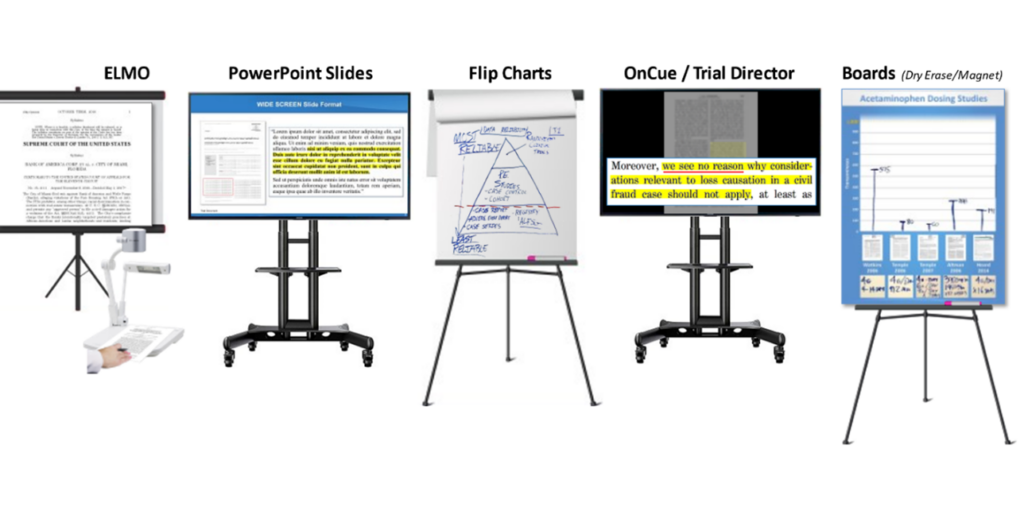How Trial Presentations Enhance Your Argument and Encourage Jurors
Test presentations work as a crucial system for enhancing lawful debates and convincing jurors. By incorporating aesthetic help, narrative structures, and psychological involvement, attorneys can create an engaging case that resonates on multiple levels. The calculated use visuals not only makes clear complex details yet additionally catches jurors' focus better than words alone. Nonetheless, the art of storytelling plays a just as crucial role in transforming accurate proof right into a compelling narrative, shaping jurors' perceptions - trial presentations. Recognizing these elements can considerably impact trial end results, raising the question of how each element adds to this complex dynamic.

Value of Aesthetic Aids
Visual aids play a vital duty in boosting the performance of test presentations, as they can considerably enhance audience involvement and retention of details. In the context of a test, where jurors are charged with processing complex details, aesthetic aids serve to streamline and make clear crucial points. Charts, charts, and pictures can communicate data and principles that might otherwise bewilder or perplex jurors, enabling for a more uncomplicated understanding of the proof presented.
Moreover, aesthetic aids assist in maintaining juror focus throughout the procedures. By breaking the uniformity of verbal testament, these tools can stress important disagreements, making them more unforgettable. Reliable visual help can also evoke emotional responses, which can be crucial in convincing jurors to line up with the presenter's story.

Crafting Compelling Stories
An engaging narrative is important in trial presentations, as it offers as the backbone of efficient persuasion. It enables lawyers to weave together facts, proof, and psychological aspects right into a systematic tale that resonates with jurors. This narrative framework enables jurors to recognize the intricacies of the instance while directing them with the attorney's debate.
To craft an engaging narrative, lawyers should focus on clearness and comprehensibility. This entails establishing a clear protagonist-- commonly the customer-- and outlining their journey with the occasions in inquiry. Offering the facts in a logical sequence enhances comprehension and preserves interaction. In addition, making use of vivid descriptions can create mental images that help jurors visualize the events, making the narrative more memorable.
Furthermore, incorporating essential styles throughout the presentation enhances the core message and help in retention - trial presentations. navigate to these guys The story ought to not only share details however also stimulate a feeling of justice, highlighting the stakes involved. Inevitably, a well-constructed story cultivates a connection in between the jurors and the instance, positioning the lawyer's disagreement as both credible visit our website and engaging, thus increasing the chance of a beneficial verdict

Involving the Jury Psychologically
Efficient court engagement hinges on the attorney's capability to attach with jurors on a psychological level. This connection can considerably affect jurors' assumptions and their ultimate decision-making.
Visual help, such as pictures or video clips, can additionally boost psychological engagement, providing jurors with vivid depictions of the instance's human elements. Crafting a story that highlights the battles and triumphs of the individuals entailed makes certain that jurors see past the lawful debates and recognize the human repercussions of their decisions.
Additionally, tone and body movement play a crucial role in conveying feeling. A lawyer's enthusiastic shipment can resonate with jurors, strengthening their emotional investment in the event. It's necessary to stabilize sob stories with factual evidence, ensuring that jurors really feel urged to act while staying grounded in the fact. Inevitably, a mentally engaged court is more probable to be convinced, making emotional link a crucial component of effective test presentations.
Structuring Your Discussion

The body of the presentation need to be logically segmented into bottom lines, each supported by compelling evidence. It is advantageous to utilize narration strategies to weave realities into a narrative that jurors can easily comply with. Aesthetic help, such as graphes and video clips, can boost understanding and interaction, helping to highlight important items of evidence.
Real-World Instance Research Studies
Examining real-world study offers invaluable insights right into the art of test presentations and persuasion. For example, the landmark case of "O.J. Simpson v. Individuals of The golden state" illustrates just how aesthetic help and compelling narratives can sway court perceptions. The protection group efficiently employed an approach that incorporated top-level professional statements with multimedia presentations, which captivated jurors and inevitably affected their this page decision.
One more notable instance is the "McDonald's Coffee Case," where the complainant's attorneys made use of graphic photos of the injuries suffered by Stella Liebeck. trial presentations. This plain visual proof played an important role in sharing the seriousness of her burns, leading to a considerable court award. Such instances demonstrate that impactful trial discussions frequently hinge on the efficient assimilation of visuals and storytelling to evoke psychological responses from jurors
Moreover, the "Casey Anthony Test" highlighted the significance of narrative comprehensibility and trustworthiness. The prosecution's failing to develop a compelling timeline reduced their influential power, highlighting the necessity of a well-structured presentation. Evaluating these instances discloses that successful trial presentations call for critical planning, emotional interaction, and the capability to resonate with jurors' values and ideas.
Verdict
Test presentations considerably improve disagreements and encourage jurors via the strategic use visual aids, compelling narratives, and psychological involvement. By streamlining intricate details and cultivating links with the target market, these components develop a remarkable and impactful experience. A well-structured discussion equilibriums psychological allures with valid proof, inevitably reverberating with jurors' worths. The integration of these techniques not just affects decision-making yet likewise highlights the value of efficient communication in the courtroom.
Comments on “Powerful trial presentations help attorneys present with confidence.”